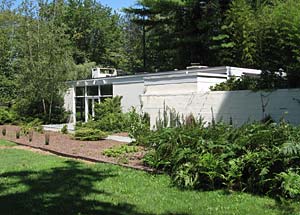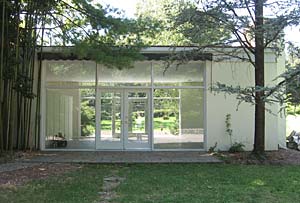Philip Johnson was perhaps the most famous of the Harvard Five and the only one of these noted mid-century Modernists whose entire residential oeuvre remains standing. That might soon change. The New Canaan Historical Review Committee’s demolition delay on his 1953 Alice Ball House, in New Canaan, Connecticut, expires today.


Located on one of New Canaan’s ritziest streets, the 1,700-square-foot Alice Ball House was designed by Philip Johnson and was finished in 1953 (top). It features 10-foot ceilings, glass-enclosed living areas, and private bedroom and service areas (above).
But hold the wrecking ball—the house could be saved if someone is willing to buy it. Located on Oenoke Road, one of New Canaan’s ritziest streets, the 1,700-square-foot residence is being offered at $3.1 million and sits just two doors down from another Modern house, designed by Edward Durrell Stone, also recently restored and on the market.
The current owner, Cristina Ross, bought the property in 2005 intending to use it as a pool house accompanying a new larger, main residence—reportedly encompassing some 7,000 to 15,000 square feet—she was hoping build on the 2.2-acre lot. After the New Canaan Wetlands Commission denied her plans in 2006, Ross acquired the right to demolish the Ball residence. But Prudy Parris, the Sotheby’s broker for the property, says that Ross is now anxious to find a buyer who will preserve it. “The house is a work of art and needs someone who will appreciate it as such,” Parris says.
Given the resounding success of the Glass House’s public opening last summer—tours of Johnson’s compound are sold out almost a year in advance—and the increasingly mainstream appreciation of Modern architecture, the uncertain future of the Ball house surprises many observers. But Johnson scholar Hilary Lewis points out that other trends are at work.
“We’ve seen a resurgence of interest in Modern design, but there’s been a change in people’s attitude toward size,” Lewis explains. “Johnson’s houses are part of what makes New Canaan special, but they require a different kind of living. Philip [Johnson] was proof positive that you can live comfortably in less than 2,000 square feet.”
Size may indeed be part of the problem. The Alice Ball House has been on the market for six months, and while Parris notes that in the New Canaan market many houses take that long to sell, most buyers in the area are looking for “a five-bedroom Colonial.” With two bedrooms and tile floors, though, the Ball House isn’t exactly family friendly.
According to Stover Jenkins, the author of The Houses of Philip Johnson, Johnson’s design for Alice Ball, a single woman in the conservative 1950s, was influenced by Mies Van der Rohe’s unbuilt Resor House. It features 10-foot ceilings, glass-enclosed living areas, and private bedroom and service areas.
“It’s a very rationalist house,” Jenkins says, adding that that its massing and siting give the composition the feeling of a romantic garden villa. “It’s not one of Johnson’s masterpieces, but it’s part of a collection of houses he designed in New Canaan. That collection is unique. When you start demolishing parts of a group, it’s like taking apart a community.”
Not everyone shares this view. “We shouldn’t preserve these houses in amber,” says William Earls, AIA, author of The Harvard Five in New Canaan. “What’s more important is the spirit in which they were built. They’re an inspiration point for what should happen now. What are we doing now [architecturally] that people will be interested in fifty years?”
Not much, preservationists contend. If the house were demolished, they say, most likely it would be replaced by a McMansion—cheap enough to compensate for the exorbitant price of the property and large enough to accommodate today’s families’ need for space. While such a house might be more financially practical, Lewis foresees the emotional downside of destroying the work of a Pritzker Prize winner. “I have no doubt that if and when we lose the Alice Ball House, people are going to feel a great sense of loss and ask, ‘Wow, why did we do that?’”



